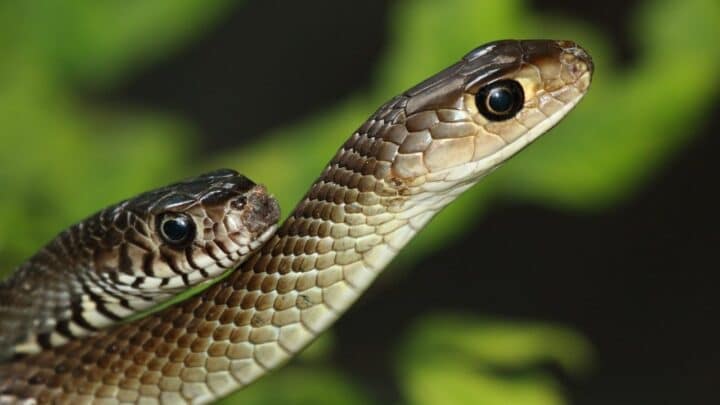Rat snakes are common throughout all of North America and are famous for being both non-venomous and non-aggressive.
In fact, given their penchant for chomping down on rodents and insects, they’re usually a welcome ally for farmers who are trying to protect their crops from pests.
Their unique and useful feeding habits had me wondering about the diet of baby rat snakes. Rodents are not that always small, all things considered, so how does a baby rat snake keep itself fed?
What Baby Rat Snakes Eat
Rat snakes feed on a variety of rodents, as well as on insects. However, baby and juvenile rat snakes cannot always manage the size of rodents, so they are more likely to feed on smaller, cold-blooded prey like frogs, lizards, and insects.
What Baby Rat Snakes Eat in the Wild
Rat snakes are constrictors, which means they squeeze their prey to death and eat it whole. And what’s more, they’re part arboreal, which means they’re able to climb trees.
They’re also excellent swimmers.
Together, these skills mean they can hunt in various spaces.
In the wild, because baby rat snakes cannot feast on larger prey like their parents, they will often make do with a smorgasbord of cold-blooded creatures, including frogs, toads, newts, and lizards.
They’re not crazy about insects, but juvenile rat snakes have been known to feed on moths, beetles, crickets, spiders, and caterpillars if they’re out of options.
If a baby rat snake comes across some small birds’ eggs, there’s a chance they may eat them, too.
In the wild, where there is an adapt-or-die mentality, rat snakes are less fussy about their food and more likely to eat what they need to survive, in relation to their size.
What Baby Rat Snakes Eat in Captivity
In captivity, it’s far easier to control what baby rat snakes eat, and breeders have a few different dietary options at their disposal from specialty pet stores.
Generally speaking, the easiest thing to feed baby rat snakes is pinky mice that are bought frozen and then thawed.
If they’re too big for your small snakes, you can cut them in half.
Feeding rat snakes pinky mice from a young age will get them used to this kind of prey early on, making them less inclined to turn into picky adults.
However, if your baby rat snakes aren’t interested in pinky mice, you can try feeding them insects or small reptiles.
Once they are bigger, you can try them on feeder chicks.
How to Feed Baby Rat Snakes in Captivity
When it comes to feeding baby rat snakes, the rule of thumb is that they should not be given any pieces bigger than the widest part of their bodies.
If you’re unsure, rather feed them plenty of smaller pieces than a few larger pieces.
Baby snakes usually like to eat about twice a week. A way to check if they’re ready for their next feed is to monitor their bathroom habits.
Once they’ve pooped, they’re up for their next meal.
A word of advice when feeding baby snakes is never to use your fingers, but instead to use tongs or tweezers. This way, they won’t associate you with food.
As a final note, baby snakes are more inclined to feed at temperatures between 80- and 90-degrees Fahrenheit (26- to 32-degrees Celsius), so try to maintain this climate in their enclosures.
Identifying Baby Rat Snakes
The term “rat snake” encompasses a huge number of different snakes of numerous genera. In terms of commonality, they are all medium or large constrictors that are non-venomous and predominantly hunt and feed on rodents.
Their docile and non-aggressive natures make them exceptionally popular pets, although some breeds can be a little feistier than others.
Regarding appearance, rat snakes have bright white or creamy yellow chins and differ in scale color depending on their species. Generally, they are variegated red, brown, grey, yellow, or black and white.
These remarkable creatures rattle their tales when they feel threatened in mimicry of their scarier cousin, the rattlesnake.
This adaptation developed as a means for them to warn off potential predators, including well-meaning humans.
This goes without saying, but no matter how sure you are that you’ve come across a rat snake, never approach it in the wild without a trained professional present.
Frequently Asked Questions about What Baby Rat Snakes Eat
When are baby rat snakes born?
Baby rat snakes are usually born either in early fall or late in summer. Their mums lay eggs about 5 to 7 weeks before this, usually in July. Once they are born, juvenile rat snakes will stay close to their families for about two years.
Are rat snakes dangerous to humans?
These relatively docile animals pose no threat to humans, as they are not venomous. Some species of rat snake can exert small amounts of venom, but not enough to cause any significant harm to a human being.
What are corn snakes?
Corn snakes are a type of rat snake. They’re among the most popular snake species to be kept as pets. They are lovely animals that are not aggressive, and they generally aren’t picky eaters either.
Conclusion
Rat snakes are a marvel of the natural world largely because of their symbiotic relationship with humans. They are the opposite of harmful.
In fact, they protect the food that’ll eventually end up on our dinner tables.
While they may not be everyone’s cup of tea, the peaceful rat snake just goes to show that all snakes aren’t that bad. On the contrary, these guys are a very necessary part of our ecosystem.


